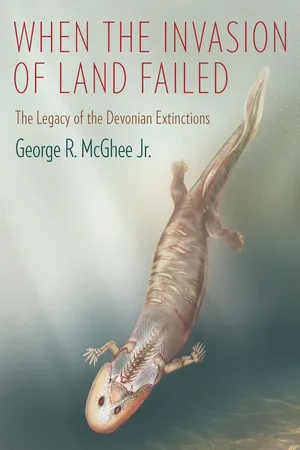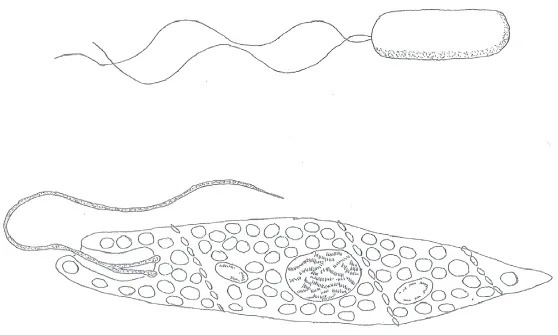![]()
CHAPTER 1
The Evolution of Life on Land
The Long Beginning
The planet Earth is 4,560 million years old. For over 3,000 million years, life on Earth was confined to the oceans, and the land areas of the planet looked much like the rocky landscapes of Mars today. Complex life on land, and the terrestrial ecosystem, is a relatively new phenomenon in the history of the Earth. The oldest simple terrestrial ecosystems of macroscopic organisms—plants, fungi, and animals—can be traced back only to the middle of the Ordovician Period of geologic time (for the geologic timescale, see table 1.1),1 some 468 million years ago. That is, only in the past 10 percent of the total age of the Earth has complex life evolved to the point where it could emerge from the oceans and conquer the hostile environment of the terrestrial realm.
It is not easy living on land. Dehydration is a very serious problem for land-dwelling organisms. Many of the morphological and physiological changes that took place in the evolutionary sequence of fish to amphibians to amniotes were adaptations for preventing water loss in the dry environments of the land, where animals are surrounded only by the thin gaseous layer of the atmosphere. Life in the sea is surrounded at all times by water; dehydration is an unknown phenomenon. Land-dwelling organisms must deal with the crushing force of gravity, whereas, for neutrally buoyant swimming fish out in the oceans, gravity is an unknown phenomenon. Life in the oceans experiences very little variation in temperature; in places where temperature does vary, the change is very slow, gently rising and falling with the passing of the four seasons of the year. In contrast, land-dwelling organisms deal with large fluctuations in temperature that occur very rapidly: every 24 hours, temperatures quickly increase as the fireball that is the sun rises above the horizon, and they fall just as quickly as the sun sets into the cold darkness of the night. Even today, under the protective screen of the Earth’s ozone layer in the upper atmosphere, land-dwelling organisms are subject to radiation burns from that same fireball of the sun—radiation burns that can lead to fatal skin cancers. For much of the history of the Earth, that ozone layer did not exist at all, and the intense ultraviolet radiation flux present on the continental landmasses was deadly. In contrast, water is a very good radiation shield, and marine organisms located just a few centimeters below the surface of the oceans are protected from ultraviolet radiation from the sun.
TABLE 1.1 The geologic timescale.
Source: Modified from Gradstein et al. (2004), Walker and Geissman (2009), and Erwin et al. (2011).
Abbreviations: Ma BP = millions of years before the present.
Thus land-dwelling organisms have had to evolve complex adaptations to deal with four particularly serious problems that do not exist for organisms in the oceans: dehydration, gravity, temperature fluctuations, and radiation poisoning. The last problem was initially the most serious; it took 3,000 million years of environmental change for the radiation flux present on land to decrease to livable levels and evolutionary change for organisms to adapt to life on land.
Life on Earth Today
Three types of life exist on Earth today: the archaea, the bacteria, and the eukarya (table 1.2). The simplest forms of life are the unicellular; that is, they exist as a single individual cell. There are two types of unicellular life (fig. 1.1): the prokaryotes (simple cells) and the eukaryotes (complex cells). Prokaryotes are the simplest forms of unicellular life: their small cells have no nucleus and no organelles but consist only of a cell membrane within which the chromosomes of the organism are enclosed. The chromosomes contain the DNA of the organism, the coding mechanism of life on Earth. For many years it was thought that there was only one type of prokaryote life on Earth, the bacteria. Then, in 1977, microbiologist Carl Woese discovered that another type of prokaryote life existed—the archaea—a discovery for which he received the Crafoord Prize.2 The archaea and bacteria look very much like one another when viewed under a microscope, but their genetics are quite different. The easiest way to tell the two types of life apart is by examining their cell membranes: the bacteria have ester-bonded lipid membranes, and the archaea have ether-bonded lipid membranes. Because the possession of a cell membrane is one of the fundamental characteristics of life (the other being the possession of DNA), the difference in cell-membrane construction between bacteria and archaea is of major evolutionary significance.3
TABLE 1.2 A phylogenetic classification of life.
| Archaea (prokaryote cells with ether-bonded lipid membranes) |
| Bacteria (prokaryote cells with ester-bonded lipid membranes) |
| Eukarya (eukaryote cells) |
| – Bikonta |
| – – Rhizaria |
| – – Excavobionta |
| – – Chromoalveolata |
| – – Green eukaryotes |
| – – – Glaucophyta |
| – – – Metabionta (unicellular to multicellular bikonta) |
| – – – – Rhodobionta (red algae) |
| – – – – Chlorobionta (green algae + land plants) |
| – Unikonta |
| – – Amoebozoa |
| – – Opisthokonta |
| – – – Fungi |
| – – – – Microsporidia (unicellular fungi) |
| – – – – Eumycetes (unicellular to multicellular fungi) |
| – – – Choanozoa |
| – – – – Choanoflagellata (unicellular choanozoa) |
| – – – – Metazoa (multicellular choanozoa, the animals) |
Source: Modified from the phylogenetic classification of Lecointre and Le Guyader (2006).
Note: Multicellular eukaryote clades are marked in bold-faced type.
FIGURE 1.1 Top: a prokaryote cell, the bacterium Rhizobium leguminosarum. Bottom: a eukaryote cell, the excavobiontan Euglena spirogyra. Credit: Modified and redrawn from Lecointre and Le Guyader (2006).
In our day-to-day lives we are surrounded by a sea of bacteria, but we usually do not notice them because they are so small that they are invisible to the naked eye. Some of these bacteria are very beneficial to us: the Escherichia coli (“E. coli”) bacteria that live in our intestines help us to digest food (but are beneficial only if they remain in our intestines!). Others can be deadly: Clostridium botulinum will kill us with botulism, and its cousin Clostridium perfringens will give us gangrene. For the most part, however, the bacteria around us are benign and simply coexist with us.
The archaea usually live in extreme environments; thus, in our normal lives we do not encounter them as often as we do the bacteria.4 Some, like Methanopyrus kandleri, live at the bottom of the oceans in volcanic hydrothermal vents, under incredible pressure and in water as hot as 110°C (230°F). Others, like Thermoplasma acidophilum, flourish in the waste pits of coal mines, in sulfuric acid–rich waters with a pH value as low as one.
In contrast to the prokaryotes, the eukaryote unicells are much larger and more complex forms of life (fig. 1.1). Eukaryotes possess a nucleus (which contains the chromosomes) and specialized organelles such as chloroplasts (which can produce food for the cell by photosynthesis), mitochondria (which mediate the energetic enzyme activities of the cell), and Golgi apparati (for processing proteins within the cell). The difference in size between the simple prokaryote unicells and complex eukaryote unicells is striking: the prokaryote bacterium Rhizobium leguminosarum illustrated in figure 1.1 is 2 micrometers (0.08 thousandths of an inch) long, and the eukaryote Euglena spirogyra is 120 micrometers (4.7 thousandths of an inch) long. That is, the single eukaryote cell is 60 times larger than the prokaryote cell!
It has been proved that the organelles of the eukaryote cell were once separate, independent bacteria. For example, the chloroplasts of a eukaryote cell were once free-living cyanobacteria, and the mitochondria were once free-living purple bacteria.5 Even today, the mitochondria within the cells in our bodies still possess their own DNA, which is separate from the DNA in the nucleus of our cells that codes for the cell’s reproduction. The evolution of the eukaryote cell from the prokaryote cell occurred by the process of biological symbiosis: first as colonies of cooperating independent cells, and then later as a complex single cell of dependent organelles. This evolutionary transition had occurred by 2,100 million years ago, and the geologic evidence for the occurrence of this event will be considered later in this chapter.
The eukarya are the third form of life on Earth (table 1.2), and they all possess eukaryote cells (hence their name). The eukarya split into two separate lineages, the bikonta and the unikonta, early in their evolutionary history (table 1.2). The unicellular forms of these two groups are easy to tell apart: the bikonta have two flagella, and the unikonta have only one flagellum. We are unikonts, and the single flagellum of the human sperm cell is an ancient inherited trait from our unicellular ancestors.
The eukarya include both unicellular and multicellular forms of life (table 1.2). Multicellular organisms evolved in the same fashion as the eukaryote cell itself, i.e., by biological symbiosis, in which free-living eukaryote cells first formed colonies of cooperating independent cells and then multicellular tissues composed of dependent and specialized cells. However, the evolution of multicellularity in the eukarya is convergent—it occurred at least three times independently.6 In the lineage of the bikonta, multicellularity occurred in the evolution of the metabionta, the red and green algae (table 1.2). In the lineage of the unikonta, multicellularity occurred twice. First, the lineage of the opisthokonta produced the fungi and their sister group the choanozoa. The clade of the fungi is divided into the microsporidia, which remained unicellular, and their sister group, the eumycetes, which evolved multicellularity. Second, the clade of the choanozoa is divided into the choanoflagellata, which remained unicellular, and their sister group the metazoa, which independently evolved multicellularity (table 1.2). Thus the trees, mushrooms, and humans we encounter in our daily lives are all independent inventions of multicellularity by the ancient unicellular eukarya. The bikonta were the first to evolve multicellularity, producing the green algae some 1,200 million years ago, with the unikonta evolving multicellular animals only 780 million years ago, as will be discussed later in this chapter.
The Earliest Life on Earth
It is not known how life originated on Earth. We do know that the most ancient fossils of life yet discovered—simple, prokaryote cells like those found in living archaea and bacteria—are 3,450 million years old. Geochemical evidence suggests that life was present on Earth 3,830 million years ago, though actual fossil cells have yet to be found that are that old.
The first item of geochemical evidence for the presence of life 3,830 million years ago comes from the analysis of carbon isotopes present in the ancient strata. The carbon atom has two stable isotopes, carbon-12 and carbon-13. Carbon-12 possesses six neutrons and six protons in the nucleus of the atom, and the heavier carbon-13 possesses seven neutrons and six protons in its nucleus (carbon has another, heavier isotope, carbon-14, which is unstable and radioactively decays to nitrogen-14). Photoautotrophic organisms prefer the lighter isotope of carbon in photosynthesis; that is, photosynthetic bacteria preferentially extract carbon-12 from the atmosphere to synthesize hyd...





